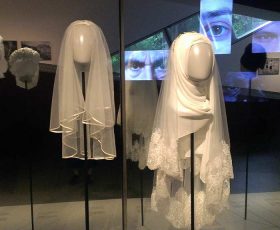The Italian Writer Elena Loewenthal Reflects on Strong Jewish Women in the Torah
The current exhibition Cherchez la Femme, which explores religious dress codes for women from women’s perspectives, remains on display until 27 August (more about the exhibition on our website). When I first found out the exhibition’s theme, I immediately thought of the novel Attese (2004) by the Italian author Elena Loewenthal. (The title means either “expectations” or “times of waiting.”) In four extended sections, the novel tells the stories of different Jewish female characters throughout the ages. But the novel’s real main character is a mysterious veil that follows the protagonists from Biblical times to modern-day Venice.
We can read the veil as a metaphorical vessel of Jewish memory that women have guarded and passed on, a vessel that embodies recollection and forgetting, tradition and renewal. Indeed, the reasons each woman in the novel dons the veil are not only cultural (such as marking mourning) but personal: each of them reshapes it, sews in her own threads, or at least cultivates an idiosyncratic relationship with the garment she inherited.
The author, who (besides being a writer and Hebrew-to-Italian translator) is a lecturer in Jewish Studies at Vita-Salute San Raffaele University in Milan, dedicates the first section to the biblical figures of Rebecca and Tamar. Asked in an interview why the veil plays such a significant role in the novel, Elena Loewenthal responded:
The mere idea that a woman would cover herself for the sake of revealing herself is the subject of an uncanny fascination. These days, much is said about head coverings as tools for excluding women, who cover up to conceal themselves from everyone – except their husbands. Rebecca and Tamar, the only women in the Bible who wear veils (which is why I tell their stories) do the opposite. They use veils to seduce and to draw the attention of the man they want; also, they put on their veils at the precise moment he arrives. I very much appreciated that.

In the exhibition Cherchez la femme visitors are greeted with quotes of the Torah. This quote (Genesis 24) deals with Rebecca and how she covers her head with the veil; Jewish Museum Berlin, photo: Mirjam Bitter
From Genesis 24, we have the story of Abraham sending off his servant Eliezer to find a bride for his son Isaac from his native land, Canaan. There he meets the young Rebecca. When her family asks her “Wilt thou go with this man?” she replies – with a confidence and outspokenness that is unusual for biblical women characters – “I will go” (Genesis 24:58). Loewenthal expands most on the final scene, in which she meets Isaac and veils herself, a gesture Loewenthal sees as an act of love.
Rebecca was positive about this blind love… Isaac knew nothing about her… Isaac [was] clueless, unlike Rebecca. For that reason, perhaps, and not to hide herself, she took the veil and covered herself as soon as she had recognized him from a distance, almost at the limits of her vision. The cloth was wrinkled from the road, woven through with expectation and hope. It was an instinctive gesture but also a heartfelt one. (Attese, p. 10)
From Isaac’s perspective, the gesture of self-veiling is mainly one of motion, of “drawing in the air” (Attese, p. 20). The gesture also sets Isaac in motion and jerks him back to the present from the trauma of his near-sacrifice by his father. (The museum has also put on an exhibition about what is known as the “binding of Isaac”; more about Obedience on our website). In Loewenthal’s novel, Isaac mainly notices Rebecca’s eyes and that she does not lower her gaze, another sign of her self-confidence.
With the story of Tamar, the novel moves on to a less prominent, but also idiosyncratic female biblical figure from Genesis 38. In her case, the veil does serve to conceal but at the same time to seduce. Using her veil, Tamar compels her father-in-law Judah to conceive a child with her. Because she hides her shorn hair, the symbol of a mourning widow, Judah takes his daughter-in-law for a prostitute. Thus Tamar finally quenches her “maternal thirst” (Attese, p. 27) and exercises her right to motherhood.
To elaborate, Judah had refused to allow the widowed Tamar to marry his youngest (adult) son Sela as tradition stipulated. He was afraid that Sela might die young like his two older brothers. What the Torah specifies but Loewenthal’s book omits is that the twins born of Tamar’s encounter with Judah, Serach and Perez, would sustain the onward course of Jewish history. After all, Perez was an ancestor of King David.
Not only does the author present a new perspective on two interesting women from the Bible, she also shows her readers that veils and headscarfs are not markers of repression per se: they can be personally chosen for personal motives.
Dr. Mirjam Bitter, the editor of Blogerim and a literary translator from Italian to German, still hopes someday to please her doctoral adviser by finding a German press to publish Attese in her translation.
I’ve explored in greater depth how the veil serves as a female-coded metaphor for memory in Elena Loewenthal’s Attese in the chapter “Erlösungsfiguren? Geschlechtercodierte Gedächtnismetaphern zwischen Entsakralisierungsabsicht und Sinnstiftungstendenzen” (Figures of Redemption? Gender-Coded Memory Metaphors from Intended Profanation to Trends in the Creation of Meaning) of my monograph Gedächtnis und Geschlecht: Darstellungen in der neueren jüdischen Literatur in Deutschland, Österreich und Italien (Memory and Gender: Representations in Recent Jewish Literaure in Germany, Austria, and Italy; Wallstein 2016).
